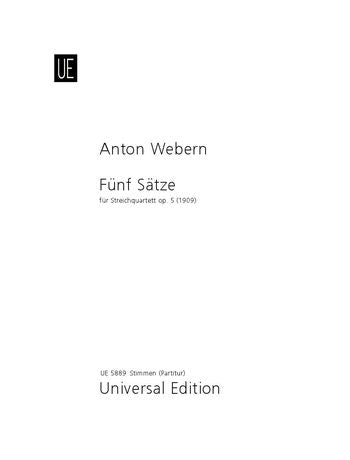
UNIVERSAL EDS/WIENER/PRESSER - 864872
Webern 5 Movements for string quartet - op. 5
Composer: Anton Webern
Publisher: Universal Edition
Instrumentation: Violin I, Violin II, Viola, Cello
Ensemble: String Quartet
Format: Chamber Parts
Webern 5 Movements for string quartet - op. 5
Juilliard Store
144 West 66th Street
New York NY 10023
United States
Choose options
Webern 5 Movements for string quartet - op. 5
Juilliard Store
144 West 66th Street
New York NY 10023
United States
Webern 5 Movements for string quartet - op. 5
Juilliard Store
144 West 66th Street
New York NY 10023
United States
Webern composed these pieces in 1909. Despite some reminiscences of Schönberg, they have no model in older quartet literature, so the composer dispensed with the title (String Quartet No 1) so heavily burdened by tradition; its five movements are also contrary to such “classical” conventions.
The centre of the work is all hectic, scurrying motivity: a scherzo distorted to the extreme, framed by two exceedingly slow, quiet pieces, each of them 13 bars long, in which Webern opens new sonic possibilities for the string quartet by piling on directions to the performers such as “with mute,” “pizzicato,” “on the bridge” and “col legno” (with the wooden back of the bow). The first movement – at 55 bars, the most extensive – seems the most traditional, reminiscent of first-movement sonata form with its classic thematic contrast: the stark antitheses of 16th-note motion around the interval of the major seventh and broad melisma sounding almost “Viennese” with its thirds and sixths.
The closing movement, a bleak epilogue, resembles the first in its variety of contrasting textures, although they resist joining into a cohesive construct.
The phrases, built from brief elements, are characteristic of the entire piece. They no longer observe metrical bar-lines; they are static soundscapes, favouring dissonant intervals such as the tritone and major seventh in their melodic shaping and harmony, refuting conventional string sound and fluctuating between brutal aggression (Rudolf Kolisch spoke of “expressionistic miniatures”) and barely audible, vanishing whispers.
Webern reworked the piece for string orchestra in 1928/29, greatly improving the composition’s plasticity and lucidity by diversifying the ensemble.
Manfred Angerer
